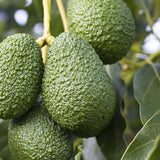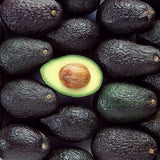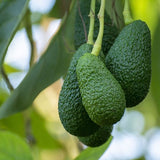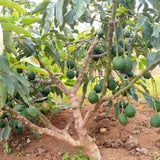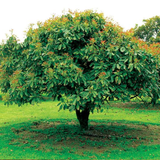Remove fruits in first 2 years until stems strong enough to hold fruits. Hass grafted avocado tree
Scientific name: Persea Americana,
English Name: Avocado
Local Name: Kotapela (B)
General information
The avocado, a tree is classified as a member of the flowering plant family Lauraceae. It is medium to large tree, 9-20m in height. The avocado is classified as an evergreen, although some varieties lose leaves for a short time before flowering. The fruit of the plant, also called an avocado, is botanically a large berry containing a single large seed. Leaves are 7-41 cm in length and variable in shape (elliptic, oval, lanceolate). They are often pubescent and reddish when young, becoming smooth, leathery, and dark green when mature.
Health benefits
Recently anti-cancerous activity has been reported in extracts of leaves and fresh shoots of avocado. Oil extracted from the seeds has astringent properties, and an oral infusion of the leaves is used to treat dysentery. The skin of the fruit has anti-helmintic properties. The avocado is also said to have spasmolitic and abortive properties. The seed is ground and made into an ointment used to treat various skin afflictions, such as scabies, purulent wounds, lesions of the scalp and dandruff. The flesh is also used in traditional medicine. Grounded avocado seeds and bark are mixed with oil to relieve pain associated with rheumatism. Avocado flesh is used to relieve pain and itchiness caused by sunburn.
Livestock benefits
The fruit is an important food source for pigs and other livestock. The tree is also used for honey harvesting.
Human benefits:
The tree is grown for its nutritious fruit that has long been important in the diets of the people around the world. Consumption is most often as an uncooked savoury dish mixed with herbs and/or spices, as an ingredient of vegetable salads, or as a sweetened dessert. However, its texture and colour can be used to enhance the presentation and consumption of many foods. The easily digestible flesh is rich in iron and vitamins A and B; providing a highly nutritious solid food, even for infants. The high oil content which is used by the cosmetic industry in making soaps and skin moisturizer products. Wood of Persea is also used for house building, light construction, furniture, cabinet making, agricultural implements, carving, sculptures, musical instruments, paddles, small articles like pen and brush holders, and novelties. It also yields a good-quality veneer and plywood. The wood is brittle and susceptible to termite attack.
Planting and tree management
Planting distances depend on the soil type and fertility. Trees are to be planted from 5-7m in rows and 7-9m between rows. Pruning must be done during the first 2 years for it encourages growth and branching.
Cultivation details
Different forms of the plant can succeed in a range of climates, ranging from subtropical with occasional frosts to lowland and highland tropics, where it can be grown at elevations as high as 2,800 metres. It grows best in areas where annual daytime temperatures are within the range 14 - 40°c, but can tolerate 10 - 45°c. hen dormant, the plant can survive temperatures down to about -4°c, but young growth can be severely damaged at -1°c.It prefers a mean annual rainfall in the range 500 - 2,000mm, but tolerates 300 - 2,500mm.






